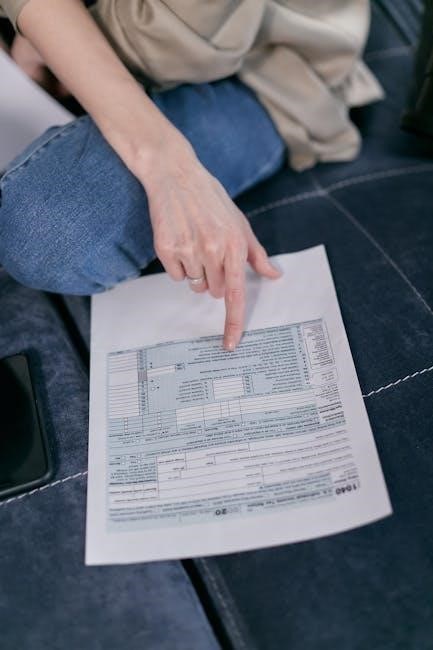Schedule L is used by organizations filing Form 990 or 990-EZ to provide information on financial transactions with interested persons, as per IRS guidelines and regulations always.
Purpose of Schedule L
The purpose of Schedule L is to provide information on certain financial transactions or arrangements between the organization and interested persons, such as officers, directors, and key employees. This schedule is used to disclose transactions that may be subject to scrutiny by the IRS, including loans, grants, and business transactions. The information reported on Schedule L is used to determine whether the organization has engaged in any prohibited transactions or has provided excess benefits to interested persons. By completing Schedule L, organizations can demonstrate their compliance with IRS regulations and provide transparency into their financial dealings with interested persons. The schedule requires organizations to report the type and amount of transactions, as well as the names and relationships of the interested persons involved. This information is used to ensure that organizations are operating in accordance with their exempt purpose and are not providing undue benefits to individuals or entities. Overall, the purpose of Schedule L is to promote transparency and accountability in the financial dealings of tax-exempt organizations.
Transactions with Interested Persons
Transactions with interested persons, such as officers, directors, and key employees, must be reported on Schedule L. This includes loans, grants, and business transactions between the organization and these individuals. The schedule requires disclosure of the type and amount of transactions, as well as the names and relationships of the interested persons involved. Organizations must also report any transactions with disqualified persons under section 4958, including excess benefit transactions. The IRS uses this information to determine whether the organization has provided excess benefits to interested persons or has engaged in prohibited transactions. By reporting these transactions, organizations can demonstrate their compliance with IRS regulations and provide transparency into their financial dealings with interested persons. The information reported on Schedule L is used to ensure that organizations are operating in accordance with their exempt purpose and are not providing undue benefits to individuals or entities. This transparency helps maintain public trust in tax-exempt organizations;

Filing Requirements for Schedule L
Organizations filing Form 990 or 990-EZ must complete Schedule L to report transactions with interested persons, as required by the IRS, every year always.
Form 990 or 990-EZ Filers
Organizations that file Form 990 or 990-EZ are required to complete Schedule L to provide information on certain financial transactions or arrangements with interested persons. The IRS uses this information to ensure compliance with tax laws and regulations. Organizations must carefully review the instructions for Schedule L to ensure accurate reporting. The schedule requires disclosure of transactions with interested persons, including officers, directors, and key employees. Organizations must also report transactions with disqualified persons under section 4958. The IRS provides guidance on completing Schedule L, including examples of reportable transactions. Organizations should consult the IRS instructions and seek professional advice if necessary to ensure compliance with the reporting requirements. By completing Schedule L accurately, organizations can demonstrate transparency and accountability in their financial dealings with interested persons. This helps to maintain public trust and ensure the organization’s tax-exempt status.
Section 501(c)(3) or 501(c)(4) Organizations
Section 501(c)(3) or 501(c)(4) organizations that file Form 990 or 990-EZ must complete Schedule L to report certain financial transactions or arrangements with interested persons. These organizations must disclose transactions with officers, directors, and key employees, as well as transactions with disqualified persons under section 4958. The IRS requires this information to ensure compliance with tax laws and regulations. Organizations must carefully review the instructions for Schedule L to ensure accurate reporting. The schedule requires disclosure of financial transactions, including loans, grants, and other arrangements. Organizations must also report compensation and other benefits provided to interested persons. By completing Schedule L accurately, Section 501(c)(3) or 501(c)(4) organizations can demonstrate transparency and accountability in their financial dealings. This helps to maintain public trust and ensure the organization’s tax-exempt status; The IRS provides guidance on completing Schedule L, including examples of reportable transactions, to help organizations comply with the reporting requirements.

Instructions for Completing Schedule L
Organizations must follow IRS guidelines and instructions carefully when completing Schedule L forms accurately always online.
Identifying Transactions with Interested Persons
To identify transactions with interested persons, organizations must carefully review their financial records and relationships. This includes examining transactions with officers, directors, and key employees, as well as with entities they control. The IRS provides guidelines on what constitutes an interested person, and organizations must ensure they understand these definitions to accurately complete Schedule L. Organizations must also consider the nature of the transactions, including sales, purchases, leases, and loans, and determine whether they are with interested persons. This requires a thorough analysis of the organization’s financial activities and relationships, as well as a clear understanding of the IRS rules and regulations. By carefully identifying transactions with interested persons, organizations can ensure they are in compliance with the IRS requirements and avoid potential penalties or fines. The process of identifying these transactions is critical to completing Schedule L accurately and successfully.
Categorizing Transactions

Once transactions with interested persons are identified, they must be categorized accurately on Schedule L. The IRS requires organizations to categorize transactions into specific types, such as grants, loans, and sales. This involves assigning a code to each transaction, which corresponds to a specific category. Organizations must ensure they use the correct codes and categories to avoid errors or inaccuracies. The categorization process requires a thorough understanding of the IRS guidelines and regulations, as well as careful analysis of the organization’s financial records. By accurately categorizing transactions, organizations can ensure they are providing a clear and complete picture of their financial activities. This is essential for maintaining transparency and accountability, and for complying with IRS requirements. The categorization of transactions is a critical step in completing Schedule L, and organizations must take the time to ensure it is done accurately and correctly. This process helps to ensure the integrity of the organization’s financial reporting.

Importance of Schedule L
Schedule L ensures transparency and accountability in financial transactions with interested persons, promoting a culture of compliance and integrity within organizations always and effectively.
Determining Independent Members
Schedule L is used to determine whether a member of the organization’s governing body is an independent member for purposes of Form 990, which is essential for maintaining transparency and accountability. The IRS considers a member independent if they are not compensated by the organization and do not have certain relationships with the organization or its management. To determine independence, the organization must review the member’s relationships and compensation, if any, and disclose this information on Schedule L. This disclosure is crucial in ensuring that the organization’s governing body is composed of independent members who can make decisions in the best interest of the organization. By completing Schedule L, organizations can demonstrate their commitment to transparency and accountability, which is essential for maintaining public trust and complying with IRS regulations. The information disclosed on Schedule L is used to evaluate the organization’s governance and management practices.
